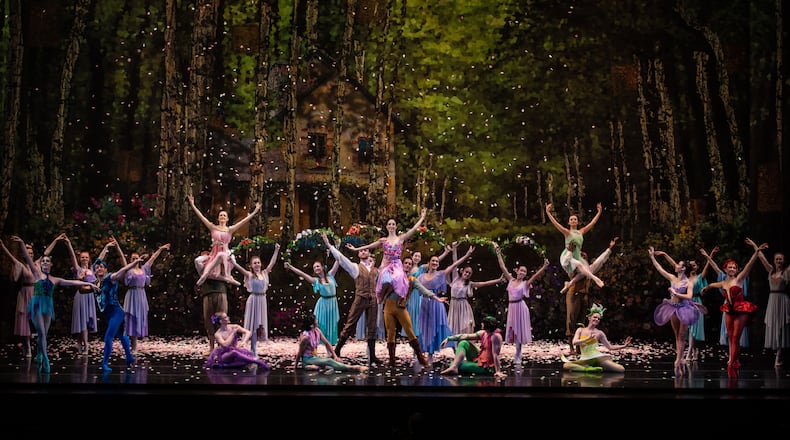Credit: DAYTON BALLET
Credit: DAYTON BALLET
Based on the 1947 Tennessee Williams masterpiece of the same name and featuring an original jazz-fueled score by Billy Sokol, “A Streetcar Named Desire” was previously staged by Dayton Ballet in 2008 and 2011. Burke is thrilled to bring her routine back to the Victoria Theatre with the addition of multimedia.
“I worked with (senior producer) Richard Wonderling and (production manager) Jason Wilson from ThinkTV, which was very exciting,” said Burke. “I hope audiences enjoy the added energy the film will bring. ‘A Streetcar Named Desire’ is a tragic but powerful story.”
Burke most recently scheduled “A Streetcar Named Desire” as part of the company’s April 2020 production of “Innovations,” which was canceled due to the COVID-19 pandemic. In order to showcase this celebratory evening of mixed repertory to the fullest, she felt the urge to ensure a story ballet would be included for the sake of artistic growth among the dancers.
“For me, story ballets are extremely important for dancers because as much as they are athletes, they are also artists,” she said. “If we don’t have these stories to tell, which is how ballet started, the art of telling stories, that part of us just doesn’t grow. When you’re just doing ballet class in the studio sometimes you don’t get to work on the artistry. Story ballets allow a chance to see more mature voices through the dancers and help them express themselves.”
Burke is equally pleased about reviving “Dear Booky,” originally staged in 2018. The title of the work takes its name from Josephine Schwarz’s personal journal.
“I was very lucky to be able to read through her personal journal,” she said. “It really struck me. I always thought she wanted to be a director or teacher but she never wanted to be those things. She particularly wanted to have a family. I thought this was really important to share. We have some of her journal prompts shown with a film before the ballet and then we have a poem she wrote that Miss Bess Imber, one of her original students, reads before the second section of the routine. As for the founders, Miss Hermene took a more quiet, supportive role and Miss Jo was more of a tour de force person.”
Credit: Walt Kleine
Credit: Walt Kleine
Living history
Bess Saylor Imber is especially well-versed in the legacies of Josephine (1908-2004) and Hermene (1902-1986) having spent more than 50 years of her life connected with Dayton Ballet.
The 82-year-old fondly recalls evolving as a dancer under the strict, impactful tutelage of Josephine, who pursued a performance career and studied with George Balanchine at the new School of American Ballet in New York City.
At age 6 Imber began studying at the Schwarz School of Dance, and at 24 became a member of Dayton Civic Ballet, which is now Dayton Ballet. She retired as a dancer at 32 but continued with the company as a teacher and choreographer, particularly becoming the first artistic director of Dayton Ballet II in 1980.
“Miss Jo was a pioneer in the education of the dance,” said Imber. “In her classes, we were taught the history of dance and her vocabulary was beyond technique. Even when I was very young – 7, 8 and 9 – she made you feel you were a part of something very grand. She also had a powerful, Shakespearean voice. She wanted us to be so strong in order to take whatever was going to be coming our way. In her class, you learned more than ballet or modern dance. It was like you were building your character. It was unbelievable. I have never felt that way before with any other teacher. She was a visionary.”
Credit: CONTRIBUTED
Credit: CONTRIBUTED
Imber says a singular component of Josephine’s visionary aesthetic stemmed from teaching modern dance in its infancy.
“The uniqueness of Dayton Ballet is that Miss Jo introduced modern dance when it was just beginning,” she said. “She was big on lecture demonstrations and enjoyed explaining modern dance and ballet. She loved educating young people.”
Imber also cherished the opportunity for creative expression during class.
“What I loved about Miss Jo’s training was that at the end of every class, she let us do our own dance, which is rare,” she said. “It was wonderful that we were able to be creative all of our young life and later on. Miss Jo made us feel like we had a unique gift. Ballet is very regimented but when you’re doing your own improvisation, it is your gift to the world. But she didn’t believe in praising anybody. You were there to serve the art form. She called art her religion. She made us feel like it was the greatest gift civilization had to offer.”
Credit: CONTRIBUTED
Credit: CONTRIBUTED
Influenced by Martha Graham and Merce Cunningham, Imber, a principal dancer with the company in the 1960s, set over two dozen works for Dayton Ballet. Her choreography has been performed by Sacramento Ballet, Tampa Ballet, and Dayton Contemporary Dance Company among others. She also worked closely with the late Jon Rodriguez, her fellow principal dancer who served with her as the company’s associate director in 1970.
Looking back on her interactions with Josephine and Hermene, polar opposites in personality but inherently bonded in their commitment to the company, Imber is grateful for their respective imprints.
“Miss Jo was full of idealism and Miss Hermene was dedicated to her idealism,” she said. “Miss Hermene, the older sister, kept Miss Jo grounded. Miss Hermene smiled, laughed and was motherly. She also made beautiful costumes and had a great, beautiful gift for photography. I wouldn’t be the person I am today without having grown up in their school.”
‘Presenting ballet in its perfection’
In addition to acknowledging Dayton Ballet’s 85th season, the production also celebrates the 95th year of the Dayton Ballet School, whose alumni includes Jeraldyne Blunden, founder of Dayton Contemporary Dance Company.
Sydor, a Dayton native working in her 17th season with The Metropolitan Opera Ballet, began studying at the Dayton Ballet School at age 7 and danced with Dayton Ballet II through high school. She also holds a BFA in dance from Butler University and an MFA in dance from University of Wisconsin-Milwaukee. She worked as a freelance dancer in New York City for 17 years, but relocated to Oakwood in 2020 after she, her husband and son sheltered in place with her family in Dayton at the outset of the COVID-19 pandemic.
Her work, “I’ll Meet You There,” is based on the Tibetan tradition of the “bardo,” a space between death and the next life/rebirth.
“In the routine there are eight souls that find themselves in the bardo at the same time,” said Sydor. “They are reflecting on their past life and reflecting on their next life. One woman in particular starts to notice another woman and they discover a soul connection. This work was also collaborative. A lot of the movement the audience will see came from the dancers. I wanted to create a collaborative, intimate environment with them. I wanted them to put their own identity into the movement.”
Credit: CONTRIBUTED
Credit: CONTRIBUTED
As she continues to create for a new generation of dance artists, Sydor hasn’t forgotten the fundamental training she received through Dayton Ballet. She credits such instructors as Gregory Robinson, Kathryn Morarity and Imber for formulating her expertise and commitment to the craft of dance.
“Miss Bess always encouraged us to dance with quality and basically our spirit,” Sydor noted. “Her love of dance came through when she would demonstrate combinations. She was not only interested in technique – her classes were hard – but she always wanted to pull that artistry, a sort of ethereal, otherworldly love, out of us, which has influenced me to this day. Gregory was loving, nurturing and had very high standards for us. My early training at the Dayton Ballet was the perfect balance between technique and artistry. I couldn’t have asked for anything better.”
Throughout Dayton Ballet history there have only been four artistic directors: Josephine Schwarz, Stuart Sebastian (1980-1990), Dermot Burke (1992-2011) and Karen Russo Burke, who began in 2011 and is retiring at the end of this season. Imber feels Sebastian, who died in 1991, and the Burkes effectively upheld Josephine’s legacy.
“All of the wonderful directors we’ve had have carried on the legacy of Miss Jo which was creativity and adherence to the perfection of ballet, which is absolute discipline,” she said. “The directors have done a beautiful job presenting ballet in its perfection. Karen, Dermot and Stuart always emphasized modern dance with classical ballet on their programs as well.”
Credit: CONTRIBUTED
Credit: CONTRIBUTED
Burke hopes the athleticism, artistry, nostalgia and scope of the “Diamond Anniversary” indicates the company is still going strong.
“I hope audiences recognize we are continuing to grow in our repertory and we are not stagnating,” she said. “I also hope audiences take away our passion and love for this art form and celebrate how fortunate we are to still be here.”
HOW TO GO
What: Dayton Ballet’s “85th Diamond Anniversary”
Where: Victoria Theatre, 138 N. Main St., Dayton
When: Feb. 10-12; 7:30 p.m. Friday and Saturday; 2:30 p.m. Sunday
Cost: $5-$86
Tickets: 937-228-3630 or visit daytonperformingarts.org
FYI: Patrons are reminded “A Streetcar Named Desire” includes depictions of sexual violence, alcohol abuse, domestic abuse and suicide.
Credit: CONTRIBUTED
Credit: CONTRIBUTED
About the Author














